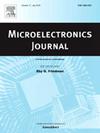An 88 dB SNDR second-order CIFF delta-sigma modulator with 3-bit quantizer and capacitor sharing circuit
IF 1.9
3区 工程技术
Q3 ENGINEERING, ELECTRICAL & ELECTRONIC
引用次数: 0
Abstract
A second-order cascaded-integrator feedforward integrator (CIFF) delta-sigma modulator (DSM) is proposed for sensor interfaces that require small area, low power, and high-resolution characteristics. It consists of two integrators containing capacitor arrays, a 3-bit quantizer based on a successive approximation register (SAR) analog-to-digital converter (ADC), and a data-weighted averaging (DWA) block. The proposed second-order CIFF DSM uses a three-bit quantizer instead of a single-bit quantizer to improve the dynamic characteristics of the DSM while reducing the area of the integration capacitors in the first integrator. In the second capacitor array used for the second integrator, a capacitor sharing circuit is implemented to perform the sampling for the second integrator, the summing for the CIFF, and the operation of the capacitor digital-to-analog converter (CDAC) for the SAR ADC-based 3-bit quantizer. The proposed capacitor sharing circuit reduces the area of the DSM for the sensor interface by eliminating the capacitors used for the summation of the CIFF and CDAC of the 3-bit quantizer. The proposed second-order CIFF DSM is designed using a 180-nm CMOS process, with an active area of 0.144 mm2. It has a sampling rate of 125 kHz, using an external clock with a frequency of 750 kHz, and consumes 145.8 μW of power at a supply voltage of 1.8 V. When it has an oversampling ratio of 512, the measured SNDR for an input signal with a frequency of 100.0 Hz is approximately 88.4 dB.
求助全文
约1分钟内获得全文
求助全文
来源期刊

Microelectronics Journal
工程技术-工程:电子与电气
CiteScore
4.00
自引率
27.30%
发文量
222
审稿时长
43 days
期刊介绍:
Published since 1969, the Microelectronics Journal is an international forum for the dissemination of research and applications of microelectronic systems, circuits, and emerging technologies. Papers published in the Microelectronics Journal have undergone peer review to ensure originality, relevance, and timeliness. The journal thus provides a worldwide, regular, and comprehensive update on microelectronic circuits and systems.
The Microelectronics Journal invites papers describing significant research and applications in all of the areas listed below. Comprehensive review/survey papers covering recent developments will also be considered. The Microelectronics Journal covers circuits and systems. This topic includes but is not limited to: Analog, digital, mixed, and RF circuits and related design methodologies; Logic, architectural, and system level synthesis; Testing, design for testability, built-in self-test; Area, power, and thermal analysis and design; Mixed-domain simulation and design; Embedded systems; Non-von Neumann computing and related technologies and circuits; Design and test of high complexity systems integration; SoC, NoC, SIP, and NIP design and test; 3-D integration design and analysis; Emerging device technologies and circuits, such as FinFETs, SETs, spintronics, SFQ, MTJ, etc.
Application aspects such as signal and image processing including circuits for cryptography, sensors, and actuators including sensor networks, reliability and quality issues, and economic models are also welcome.
 求助内容:
求助内容: 应助结果提醒方式:
应助结果提醒方式:


